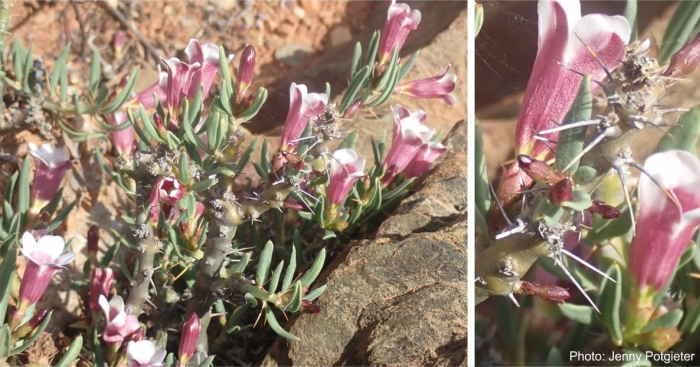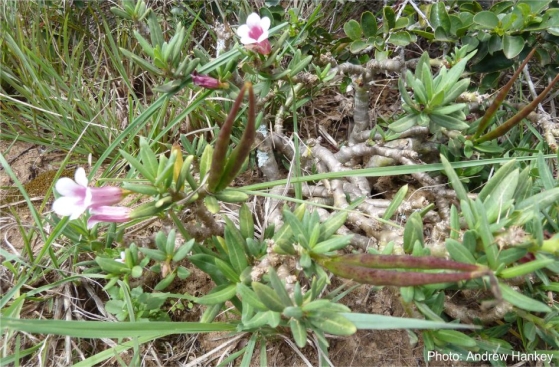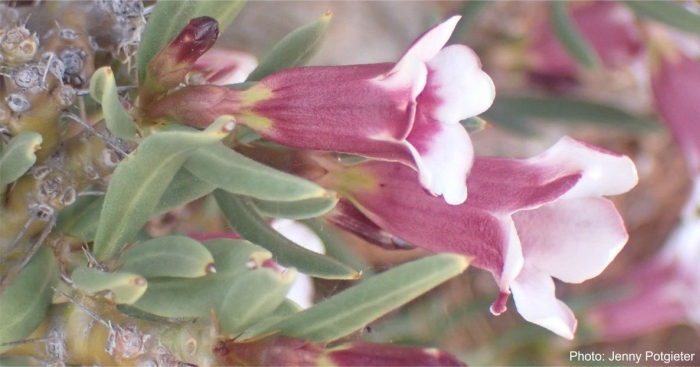Pachypodium bispinosum
Pachypodium bispinosum (L.f.) A.DC.
Family: Apocynaceae
Common names: bell-flower thick-foot (English), bobbejaankos, kafferkambroo, kragman, sterkman, dikvoet (Afrikaans)
Introduction
A spiny succulent plant that shows off with bell-shaped, purple to pink, sometimes white flowers in spring and early summer.

Description
Description
Pachypodium bispinosum is a shrublet that can reach up to about 1 m in height. It bears several to numerous slender, upright or spreading branches. The branches are armed with paired, straight spines, 10-20 mm long. It has a partially subterranean swollen stem, forming a tuber up to 600 mm tall and 250 mm in diameter. The leaves are scattered on the stems, narrow, 20-40 mm long and 20-70 mm wide, dark green and slightly rough to hairless above, hairy underneath, with margins rolled under. Its bell-shaped flowers are purple to pink, often with paler lobes, rarely white, up to 20 mm in diameter. They are borne singly or a few in a cluster, at the tips of the branches. Flowering is in spring and early summer (from August to December).

This species may be confused with Pachypodium succulentum when not in flower, but they are easily distinguished when in flower, the flowers of this species being bell-shaped, while those of P. succulentum are star-shaped. Also, the leaves of this species are less hairy, with margins curling down more distinctly and it has shorter spines.
Conservation Status
Status
Pachypodium bispinosum is not threatened and is assessed as Least Concern (LC) on the Red List of South African Plants.
Distribution and habitat
Distribution description
Pachypodium bispinosum is mostly found in the Eastern Cape province of South Africa and also in the eastern Western Cape. In its native range, it can be found in stony places, often growing amongst dry succulent scrub vegetation, on rocky slopes.

Derivation of name and historical aspects
History
The genus Pachypodium got its name from the shape of the trunk, which is wider at the base and gradually narrows with height. Pachypodium means ‘thick foot’, from the Greek pachys, which means ‘thick’, and podos, which means ‘foot’. The species name bispinosum means ‘with two spines’, referring to the paired spines that the plant bears on its stems, although it is not a unique characteristic as all pachypodiums have paired spines.
The Afrikaans name bobbejaankos, meaning ‘food of baboons’, and the name kafferkambroo refer to this plant being eaten by baboons, or being food that humans would eat only in times of extreme drought or famine, the swollen tuber being what is eaten. The names kragman and sterkman, meaning ‘strong man’ refers to the strong tuberous roots of the plants, and how difficult it is to uproot a plant.

Ecology
Ecology
The pollination of this plant may be by moths or by another insect, or a nectar-feeding bird, with a very long tongue that is able to reach all the way down the long flower tube to reach the nectar at the base. When pollination is successful, the seed pod, that resembles a pair of horns, will develop. It grows about 50 mm long and contains about 30-40 seeds. The seeds are 4-5 mm long with a tuft of whitish hairs at one end, and are dipsersed by wind.
This plant is mostly found in hot, arid places in rocky positions. They occur in frost-free environments. The plants are naturally adapted to a hot and dry environment, the succulent stems and tuberous roots allow it to store water and to survive long periods without rain.

Uses
Use
Pachypodium bispinosum can be used successfully as an ornamental plant, with its bold, shapely stems and striking flowers. In hot, dry climates it makes good subject for rock gardens, and in colder or wetter climates it is best grown in containers in a greenhouse where it can be kept warm and dry.

Growing Pachypodium bispinosum
Grow
Pachypodium bispinosum is rarely seen in gardens, but is not so difficult to cultivate and it is drought resistant. Plant it in well-drained soil, avoid waterlogged conditions and water sparingly in summer. Do not water in winter. Your watering program might vary depending on the stages of growth and changing temperatures. The plant is intolerant to cold and frost and it should be totally dry in winter. If this plant is cultivated under less than ideal conditions or allowed to get too wet in winter, it is liable to rot.
When growing in a container, the soil medium must be sandy and mixed well to allow for good drainage and prevent root rot, as the plant is likely to suffer from it. Use a large pot with holes to drain excess water. Water regularly during the summer growing season from September to April, water every day during the vegetative period, checking if the soil is completely dry before watering. During the winter season (May to September) the plant enters dormancy and watering may be stopped.
The plant can be fertilised once a month during the growing season with a fertiliser specifically for succulent plants, fertilization must be stopped in winter.
Propagation of this plant can be done by seeds and cuttings. Take stem cuttings in spring. Take 10 to 22 cm long cuttings from the younger branches and let them dry out for a couple of days until a callus forms on the surface. Dust the cut end with rooting hormone and place the cutting in your rooting medium mixture and keep in a warm and moist in a semi-shaded position. For a successful propagation you can do a lot of cuttings at the same time.
Sow fresh seeds in sandy loam soil in early summer and keep warm and moist, in a humid environment.
Pests such as red spiders and mealybugs may attack at times but can be controlled by an appropriate pesticide product.
References
- Bester, S.P. 2007. Pachypodium Lindl. (Apocynaceae). PlantZAfrica. Online. http://pza.sanbi.org/pachypodium.
- Codd, L.E. 1963. Apocynaceae. Flora of southern Africa 26. Botanical Research Institute, Pretoria.
- Giromagi cactus and succulets. Pachypodium bispinosum (L.f.) A.DC. https://www.giromagicactusandsucculents.com/pachypodium-bispinosum/. Accessed 04/01/2023.
- Raimondo, D., Van Jaarsveld, E.J. & Vlok, J.H. 2007. Pachypodium bispinosum (L.f.) A.DC. National Assessment: Red List of South African Plants version 2020.1. Accessed 2023/01/13.
- SANBI IDentifyIt-Species. Pachypodium bispinosum factsheet. http://biodiversityadvisor.sanbi.org/wp-content/uploads/sanbi-identify-it/plants/pachypodium_bispinosum.htm. Accessed 13/02/23.
- Shirley, P. 2012. Pachypodium bispinosum. Paul Shirley Succulents. Online. https://paulshirleysucculents.wordpress.com/2012/10/20/pachypodium-bispinosum/.
- Smith, C.A. 1966. Common names of South African plants. Memoirs of the Botanical Survey of South Africa No. 35. Government Printer, Pretoria.
- Smith, G.F., Crouch, N.R. & Figueiredo, E. 2017. Field guide to succulents in southern Africa. Struik Nature, Cape Town.
- Vlok, J. & Schutte-Vlok, A.L. 2010. Plants of the Klein Karoo. Umdaus Press, Hatfield.
Credits
Sisipho Mqungguthu
Karoo Desert National Botanical Garden
February 2023
Acknowledgements: the author thanks Jenny Potgieter and Andrew Hankey for assisting with pictures.
Plant Attributes:
Plant Type: Shrub, Succulent
SA Distribution: Eastern Cape, Western Cape
Soil type: Sandy, Loam
Flowering season: Spring, Early Summer
PH: Acid, Neutral
Flower colour: Purple, White, Pink
Aspect: Full Sun
Gardening skill: Average
Special Features:
Horticultural zones









Rate this article
Article well written and informative
Rate this plant
Is this an interesting plant?
Login to add your Comment
Back to topNot registered yet? Click here to register.